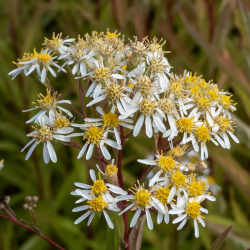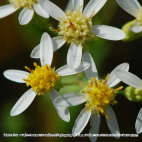Turbinate Aster Seeds
Aster turbinellus
- HOW TO GROW
- FAST FACTS
HOW TO GROW
Sowing: Direct sow Turbinate Aster wildflower seeds in late fall, planting it just under the surface and watering it once. If direct sown in the spring, the seed must be stratified first by mixing it with moist sand and stored in the refrigerator for 30 days. To start the stratified seed indoors, sow it in a flat; keep the soil evenly moist and at a temperature of 65-70 degrees F until germination, which should take place within 14-20 days. Transplant the seedlings after the last frost of spring.
Growing: This plant prefers full sun and dry to medium soil, and grows well in rocky or sandy soil. It tolerates drought well, though young plants may need watering. The lower leaves may wither in dry weather. Keep weeds under control, since this plant does not like competition. This plant often reseeds itself. Mature plants will benefit from division after two or three years of growth. Cut the stalks down to the ground at the end of the growing season for easier growth in the spring. The flowers attract numerous bees and butterflies, providing a valuable source of nectar in late fall.
Harvesting: Asters make lovely cut flowers. Cut the stems long, choosing flowers that have just opened.
Seed Saving: After flowering, the plant will produce seed heads containing small clusters of seed with white fluff. Since sparrows and goldfinches love to eat the seed, harvest it promptly to avoid loss. Cut the mature seed heads, or shake them into a container to remove the seed material. Clean Turbinate Aster wildflower seeds as well as possible, then store it in a cool, dry place.
FAST FACTS
Common Names: Prairie Aster, Smooth Violet Prairie Aster
Latin Name: Aster turbinellus
Species Origin: US Native Wildflower
Type: Native Wildflowers
Life Cycle: Perennial
USDA Zones: 5, 6, 7
US Regions: Midwest, Southeast
Seeds per Ounce: 35,000
Stratification: Cold/Wet for 4 Weeks
Germination Ease: Stratify 4 Weeks
Sunlight: Full Sun, Part Sun
Height: 36 Inches
Color: Blue, Purple
Bloom Season: Blooms Early Fall, Blooms Late Fall
Uses: Attracts Pollinators, Attracts Honeybees, Attracts Butterflies, Cut Flowers
DESCRIPTION

HOW TO GROW
Sowing: Direct sow Turbinate Aster wildflower seeds in late fall, planting it just under the surface and watering it once. If direct sown in the spring, the seed must be stratified first by mixing it with moist sand and stored in the refrigerator for 30 days. To start the stratified seed indoors, sow it in a flat; keep the soil evenly moist and at a temperature of 65-70 degrees F until germination, which should take place within 14-20 days. Transplant the seedlings after the last frost of spring.
Growing: This plant prefers full sun and dry to medium soil, and grows well in rocky or sandy soil. It tolerates drought well, though young plants may need watering. The lower leaves may wither in dry weather. Keep weeds under control, since this plant does not like competition. This plant often reseeds itself. Mature plants will benefit from division after two or three years of growth. Cut the stalks down to the ground at the end of the growing season for easier growth in the spring. The flowers attract numerous bees and butterflies, providing a valuable source of nectar in late fall.
Harvesting: Asters make lovely cut flowers. Cut the stems long, choosing flowers that have just opened.
Seed Saving: After flowering, the plant will produce seed heads containing small clusters of seed with white fluff. Since sparrows and goldfinches love to eat the seed, harvest it promptly to avoid loss. Cut the mature seed heads, or shake them into a container to remove the seed material. Clean Turbinate Aster wildflower seeds as well as possible, then store it in a cool, dry place.
FAST FACTS
Common Names: Prairie Aster, Smooth Violet Prairie Aster
Latin Name: Aster turbinellus
Species Origin: US Native Wildflower
Type: Native Wildflowers
Life Cycle: Perennial
USDA Zones: 5, 6, 7
US Regions: Midwest, Southeast
Seeds per Ounce: 35,000
Stratification: Cold/Wet for 4 Weeks
Germination Ease: Stratify 4 Weeks
Sunlight: Full Sun, Part Sun
Height: 36 Inches
Color: Blue, Purple
Bloom Season: Blooms Early Fall, Blooms Late Fall
Uses: Attracts Pollinators, Attracts Honeybees, Attracts Butterflies, Cut Flowers
Also Consider These:
-
 On Sale!
Flat Topped Aster Seeds
Aster umbellatus
Quick View
x
On Sale!
Flat Topped Aster Seeds
Aster umbellatus
Quick View
xFlat Topped Aster Seeds
Aster umbellatus
Blossoming in late summer, these soft, white flower clusters top 4' stalks. In the wild, this flat topped aster wildflower grows in moist, sandy areas or woodlands.
Starting at $3.75 USD






